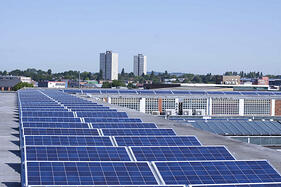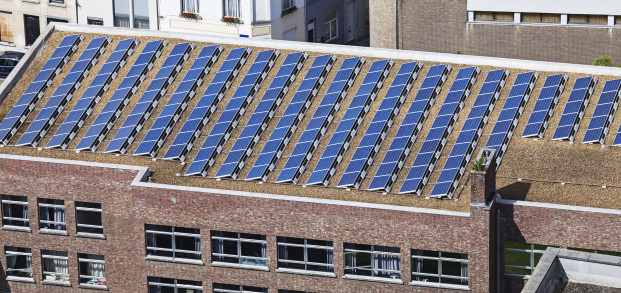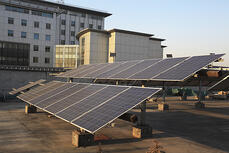 While the solar market has been exploding over the past few years, the small commercial segment of the market, made up of locations like apartment buildings, office buildings, small businesses, factories, warehouses, and hospitals, has been extraordinarily slow to develop. Residential installations, built on standardized transactions and easy access to financing because projects can be pooled based on homeowner credit scores, is red hot as large investors with cheap capital are attracted to homogenous amassed projects and the perception of well-understood credit risk. The utility scale solar market also continues to grow (despite fewer available long-term power purchase agreements) on the strength of declining costs and abundant liquidity in the form of very low cost capital driven significantly by yieldcos.
While the solar market has been exploding over the past few years, the small commercial segment of the market, made up of locations like apartment buildings, office buildings, small businesses, factories, warehouses, and hospitals, has been extraordinarily slow to develop. Residential installations, built on standardized transactions and easy access to financing because projects can be pooled based on homeowner credit scores, is red hot as large investors with cheap capital are attracted to homogenous amassed projects and the perception of well-understood credit risk. The utility scale solar market also continues to grow (despite fewer available long-term power purchase agreements) on the strength of declining costs and abundant liquidity in the form of very low cost capital driven significantly by yieldcos.
The small commercial market has been plagued by transactions that are often as complex and expensive to execute as large projects, but these small individual projects don’t carry the economic scale to absorb the cost of complex transaction structure and execution. The standardization that has brought down costs for residential pools has also yet to emerge in parallel form to support the small commercial market. Add to this unrated or high credit risk spread across a diverse set of power buyers, which has kept traditional (and inexpensive) capital sources away from this part of the market. The result is a small and very fractured market segment that has been underserved while the balance of the industry has grown at stunning rates.
These challenges for the small commercial solar market are, however, rapidly being solved and as a result we expect this part market to heat up quickly. Margins in commercial solar remain higher than in either utility scale projects or residential pools. Better transaction processes and models for standardization are being refined, as well as new tools being brought to the market like revitalized PACE programs and novel approaches to managing credit risk. This confluence of opportunity and solutions are redrawing the commercial market and attracting new and cheaper capital. Against these developments, the light commercial segment is about to become the new hot solar market.
Standardization Solves Nearly Everything
 Standardization and streamlined transaction processes are vital to the commercial market. Limited success in this segment has thus far mostly been with large corporations that would negotiate standard agreements across many sites (these corporations are also typically part of the 5% of investment grade power buyers within the small commercial market). Legal and transaction structuring fees alone have crippled the economics of many commercial-scale projects. Standardization is also critical for accessing cheap financing sources as large investors have no appetite for small single transactions, and consistency of deals and supporting documentation is necessary to aggregate multiple projects into appealing pools for these investors.
Standardization and streamlined transaction processes are vital to the commercial market. Limited success in this segment has thus far mostly been with large corporations that would negotiate standard agreements across many sites (these corporations are also typically part of the 5% of investment grade power buyers within the small commercial market). Legal and transaction structuring fees alone have crippled the economics of many commercial-scale projects. Standardization is also critical for accessing cheap financing sources as large investors have no appetite for small single transactions, and consistency of deals and supporting documentation is necessary to aggregate multiple projects into appealing pools for these investors.
Two and a half years ago, the U.S. National Renewable Laboratory (NREL) assembled the Solar Access to Public Capital (SAPC) coalition, which was brought together to build model transaction documents that could be the basis for standardization. SAPC developed a set of model contracts for solar projects, including PPAs as well as lease agreements for third party ownership. Subsequently, the Solar Energy Finance Association (SEFA) was formed to focus on refining these standardization efforts on the requirements of the financing industry for direct investment and access to secondary market options like securitization. The interest surrounding these initiatives has resulted in a real increase in the use of SEFA’s work products in the residential arena. According to John Lochner, a SEFA Board Member, standardization at the light commercial level is certainly happening, but is not yet as evolved as the residential product.
There has also been an increase in other targeted efforts at creating models for standardized projects and process. Companies active in the small commercial market are aggressively working towards consistency in documentation and process on the limited deals that they have been able to execute. One challenge to standardization is that there is a misalignment between the solar provider, the building owner and lawyers. In residential markets documentation is simple and offered on a take-it-or-leave-it basis. Building and business owners view a solar offer as a negotiation, which is typically worked into the execution of the project documents, by or with lawyers from both sides. This is a process made less efficient because the lawyers that negotiate these documents on behalf of solar buyer are generally not well versed in solar projects (and often both sides’ legal support is focused on risk management as an absolute concept and not on the materiality of the solar commitment). This void too is being filled. Understanding of the solar market is broadly improving through an understanding of the common tension points within negotiations, allowing for the development of processes and documents that are easily explained and modified – and a few lawyers (and some competing services) have even begun to take responsibility for owning this part of the process and are providing certainty for both the cost and the production of consistent project documentation.
Collectively, these developments are finally producing real standardization across portfolios of commercial projects. This initial success in standardizing the process and documentation will act as a positive feedback loop for the industry – as more projects are brought on line, the ability to standardize, and demand more standardization with potential solar buyers, will naturally increase. The result will be an accelerating reduction in the transaction costs in this segment of the market combined with an expanding pool of potential new investors and lenders.
Tools – Both New and Old – Are Solving the Credit Worthiness Conundrum
 Very few small commercial projects are associated with a credit rated company as the solar buyer. Defining credit risk, especially in a way that more conservative investors (like banks and other tax equity investors) will accept has also been a consistent challenge for the commercial solar market. This too is changing.
Very few small commercial projects are associated with a credit rated company as the solar buyer. Defining credit risk, especially in a way that more conservative investors (like banks and other tax equity investors) will accept has also been a consistent challenge for the commercial solar market. This too is changing.
Property-Accessed Clean Energy (PACE) funding allows customers to finance a solar system and pay for it as an addition to their property tax bill. PACE solves the creditworthiness problem by tying the repayment of the solar to property tax, making it much more likely to be repaid than if structured as a separate financing for just the solar property. PACE captured the imagination of the solar industry several years ago, however, Fannie Mae and Freddie Mac, followed by other mortgage underwriters refused to allow PACE funding to gain seniority over mortgages on the associated properties and the concept was dormant over the past few years. Mr. Lochner noted that a number of states have become comfortable with PACE, especially in commercial settings, and that it is a valuable tool where “you don’t have a FICO score or if you aren’t a Walmart.” There are recent PACE success stories, led by Renewable Funding in California and Greenworks Lending in Connecticut, and several other markets have passed PACE initiatives and are poised to grow quickly.
A new credit measuring tool comes from Sparkfund, a Washington, DC based start-up, which developed it’s own software-enabled process for quickly and easily building its own condensed credit scores for small commercial customers. Sparkfund’s program was designed for the energy efficiency market, but can easily be applied to solar financing. This alternative credit review will allow Sparkfund to build pools of credit risk on behalf of solar developers that large capital sources can assess and lend or invest against.
New Approaches Brings New Sources of Money
 As the commercial space begins to benefit from standardization and better credit management tools, new sources of capital are being attracted to this segment of the market. Zack Lerman of EmPower—a Long Island, New York based solar provider, is seeing a new influx of community banks and credit unions starting to fill the void for both lending and tax equity for small commercial projects. These local financial institutions can lean on long-standing rapports with small commercial businesses, and are increasingly willing to expand on existing relationships to provide financing for well-structured solar projects. Local financiers are very well suited to assess a small commercial solar customer’s ability to pay for the solar facility.
As the commercial space begins to benefit from standardization and better credit management tools, new sources of capital are being attracted to this segment of the market. Zack Lerman of EmPower—a Long Island, New York based solar provider, is seeing a new influx of community banks and credit unions starting to fill the void for both lending and tax equity for small commercial projects. These local financial institutions can lean on long-standing rapports with small commercial businesses, and are increasingly willing to expand on existing relationships to provide financing for well-structured solar projects. Local financiers are very well suited to assess a small commercial solar customer’s ability to pay for the solar facility.
This engagement by local financial institutions appears to be part of a larger trend. Bank of America and SolarCity are working to facilitate smaller and community banks to enter the market by establishing a $200 million program that allows these banks to participate in tax equity pools. The relationship between BofA and smaller investors is facilitated by projects fitting inside a standardized framework while leveraging the local institution’s knowledge of the solar customer’s creditworthiness.
Additionally, several other large investors – including yieldcos, a wide range of financial institutions and some non-traditional solar investors – are exploring financing platforms for the small commercial solar market both as direct investors and with opportunities for aggregating projects and selling these investments into the secondary markets.
Conclusion
Smaller commercial solar is a huge potential, untapped market. Improved processes for standardization, new (or renewed) financing tools, and a wave of new investors are on the verge of opening up this huge opportunity. Because small commercial has been relatively underserved, the available returns for the companies and investors that can win in this market will be better than in any other solar segment, with even larger returns available to anyone that can crack open the secondary market for these projects. The development of this market will have ripple effects throughout the distributed energy and energy efficiency industry as the lessons of how to streamline and standardize small commercial projects are exported to parallel markets.


.jpg?width=220&name=Sullivan%204c(B2402503).jpg)